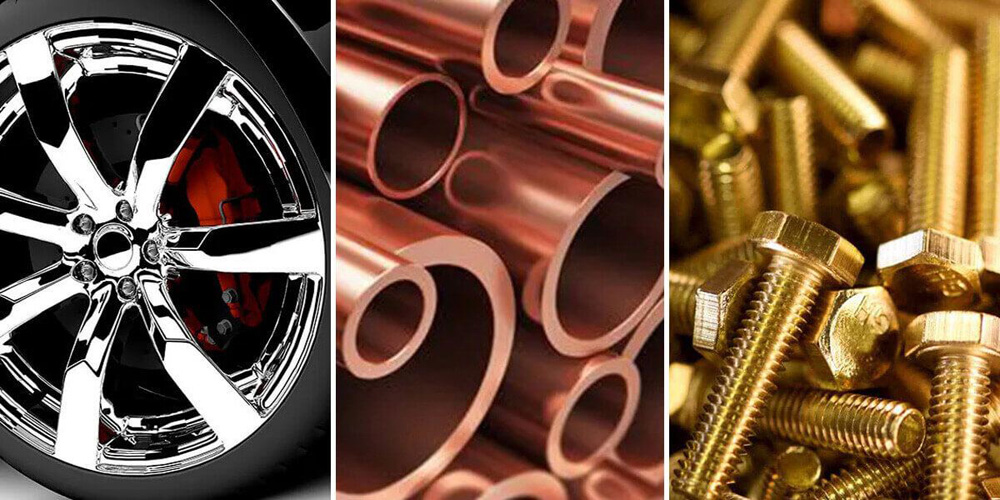
Electroplating and Metal Finishing for Industry
In today’s industrial world, electroplating and metal finishing play critical roles across numerous sectors, from automotive and aerospace to electronics, jewelry, and even the medical field. These processes are vital for enhancing the physical, mechanical, and aesthetic properties of metallic parts and components. With increasing demand for high-performance, durable, and corrosion-resistant materials, electroplating and metal finishing are indispensable techniques.
In this overview, we’ll explore electroplating, its applications, metal finishing techniques, and their importance in industrial settings.
What is Electroplating?
Electroplating is a surface treatment process in which a metal coating is deposited onto a conductive object by passing an electric current through a solution containing metal ions. The object to be coated serves as the cathode (negative electrode), while the metal to be plated acts as the anode (positive electrode). The metal ions are reduced at the cathode, forming a thin, uniform metal layer on the surface of the object.
The purpose of electroplating is to improve surface properties like corrosion resistance, hardness, electrical conductivity, aesthetic appearance, and wear resistance. Commonly electroplated metals include gold, silver, nickel, chromium, copper, zinc, and tin.
The Electroplating Process
Electroplating typically involves the following steps:
Surface Preparation: The object to be plated (known as the substrate) must be thoroughly cleaned to remove dirt, oils, oxides, and other contaminants. This is typically done using chemical or mechanical methods like degreasing, pickling, or abrasive blasting. A clean surface ensures proper adhesion of the plating material.
Pre-treatment: The substrate may be treated with a thin layer of a metal like nickel or copper before the final plating is applied. This enhances adhesion between the base metal and the top coating.
Electroplating Bath: The object is submerged in an electrolytic solution containing dissolved metal salts of the coating metal. For instance, in copper electroplating, the bath contains copper sulfate. An electric current is passed through the solution, and metal ions are deposited onto the surface of the object.
Post-treatment: After plating, the object may undergo further treatments such as polishing, passivation, or coating with protective layers to enhance its performance and appearance.
Types of Electroplating
Decorative Electroplating: This is used in industries like automotive, jewelry, and home appliances, where appearance is a key concern. Metals like chromium, nickel, and gold are commonly used to provide a shiny, attractive finish.
Functional Electroplating: Here, the focus is on enhancing specific properties such as wear resistance, electrical conductivity, and corrosion protection. Applications include printed circuit boards (PCBs), machine parts, and aerospace components.
Hard Chrome Plating: This is a specialized form of electroplating used to provide wear resistance, reduce friction, and enhance corrosion resistance. It is widely used in the automotive, aerospace, and heavy machinery industries for components like engine parts, hydraulic cylinders, and molds.
Electroless Plating: Unlike traditional electroplating, electroless plating does not require an external electrical current. Instead, it relies on a chemical reaction to deposit metal ions onto the surface. It is especially useful for coating non-conductive materials like plastics.
Commonly Electroplated Metals and Their Applications
Gold: Gold plating is primarily used in electronics (connectors, circuit boards) due to its excellent conductivity and resistance to oxidation. It is also used in jewelry for its aesthetic appeal and durability.
Silver: Silver electroplating is used in electrical components and connectors due to its high conductivity. It is also used in the jewelry industry for decorative purposes.
Nickel: Nickel plating provides a durable, corrosion-resistant surface and is often used as a base layer for other metals like chromium. It is used in automotive, aerospace, and electronics applications.
Chromium: Chromium is often used for its corrosion resistance and aesthetic finish in automotive and household applications. Hard chrome plating is used in heavy machinery for wear-resistant coatings.
Zinc: Zinc plating is commonly used for corrosion protection in steel parts, especially in the automotive industry.
Copper: Copper is used as a base layer for other platings, especially in electronic applications, due to its excellent conductivity.
Metal Finishing Techniques
Metal finishing is a broad term that encompasses a variety of processes used to improve the surface characteristics of a material. Electroplating is one form of metal finishing, but there are many others, each with distinct advantages for different industrial applications.
Common Metal Finishing Techniques
Anodizing: Anodizing is an electrochemical process that converts the surface of metals, especially aluminum, into a corrosion-resistant oxide layer. This process not only protects the metal but also allows for dyeing in various colors for aesthetic purposes. Anodizing is commonly used in aerospace and electronics industries.
Polishing and Buffing: Polishing involves mechanically smoothing the surface of a metal to enhance its appearance and reduce roughness. Buffing follows polishing and results in a shiny, mirror-like finish. These techniques are widely used in the automotive, jewelry, and consumer goods industries.
Powder Coating: Powder coating involves applying a dry powder to the surface of a metal object and then curing it under heat to form a hard, protective layer. It is widely used in automotive, construction, and home appliance applications due to its durability and excellent resistance to corrosion and wear.
Passivation: Passivation is a chemical treatment used to remove contaminants from metal surfaces and form a protective oxide layer. It is particularly important for stainless steel, which relies on passivation to prevent corrosion. This technique is crucial in industries like medical device manufacturing and food processing, where material purity is essential.
Galvanizing: Galvanizing involves applying a protective zinc coating to steel or iron to prevent rusting. Hot-dip galvanizing, where the object is submerged in molten zinc, is the most common method. Galvanized steel is used in construction, transportation, and outdoor applications due to its excellent corrosion resistance.
Electropolishing: This process removes a thin layer of material from a metal surface through electrochemical means. Electropolishing is used to achieve a smooth, clean, and corrosion-resistant finish. It is commonly used in industries where high precision and cleanliness are required, such as the medical and pharmaceutical sectors.
Importance of Electroplating and Metal Finishing in Industry
Electroplating and metal finishing are critical in numerous industrial applications due to their ability to enhance both the functionality and appearance of metal parts. Some key advantages include:
Corrosion Resistance: Electroplating and metal finishing techniques such as galvanizing, passivation, and powder coating protect metal parts from corrosion, extending their lifespan. This is particularly important in industries like aerospace, automotive, and marine, where metal components are exposed to harsh environments.
Improved Durability: By adding wear-resistant coatings, such as hard chrome or nickel, metal components can withstand extreme conditions, reducing wear and tear. This enhances the reliability of parts in industries such as heavy machinery and automotive manufacturing.
Aesthetic Enhancement: Metal finishing techniques like polishing, buffing, and decorative electroplating provide a visually appealing appearance. This is crucial for consumer goods, jewelry, and automotive industries where aesthetics play a vital role in product value.
Enhanced Electrical Properties: Electroplating with metals like gold, silver, and copper improves electrical conductivity, which is essential for the electronics industry. Circuit boards, connectors, and other electronic components rely on electroplating for optimal performance.
Precision and Cleanliness: In industries such as medical devices and pharmaceuticals, electropolishing and passivation are vital for achieving smooth, contamination-free surfaces. These processes ensure that products meet stringent cleanliness and safety standards.
Environmental and Sustainability Considerations
While electroplating and metal finishing provide substantial benefits, they also raise environmental concerns. The use of chemicals in electroplating baths, as well as the disposal of wastewater and hazardous materials, can have adverse environmental effects. Many industries are adopting more sustainable practices by recycling plating solutions, reducing hazardous waste, and exploring alternative, environmentally friendly coatings.
Electroplating and Metal Finishing
Electroplating and metal finishing are essential processes in modern industry, offering solutions to enhance the durability, functionality, and appearance of metal components. With applications ranging from aerospace to consumer electronics, these techniques are integral to manufacturing high-quality, reliable products. As industries continue to evolve, advancements in electroplating and metal finishing technology will further contribute to sustainable, efficient production methods, ensuring that industries meet the demands of both performance and environmental responsibility.


